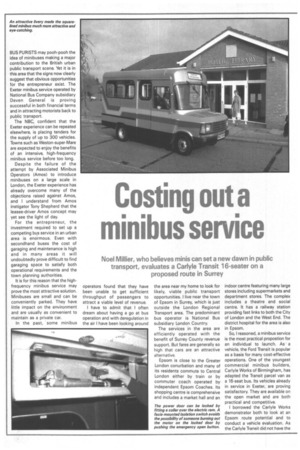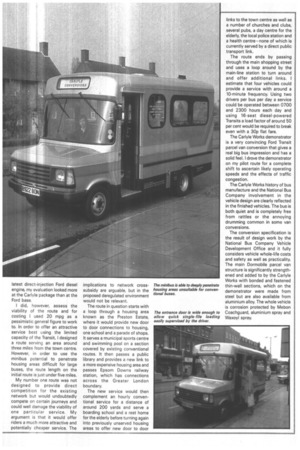Costing out a minibus service
Page 48

Page 49

Page 50

If you've noticed an error in this article please click here to report it so we can fix it.
BUS PURISTS may pooh-pooh the idea of minibuses making a major contribution to the British urban public transport scene. Yet it is in this area that the signs now clearly suggest that obvious opportunities for the entrepreneur exist. The Exeter minibus service operated by National Bus Company subsidiary Deven General is proving successful in both financial terms and in attracting motorists back to public transport.
The NBC, confident that the Exeter experience can be repeated elsewhere, is placing tenders for the supply of up to 300 vehicles. Towns such as Weston-super-Mare are expected to enjoy the benefits of an intensive, high-frequency minibus service before too long.
Despite the failure of the attempt by Associated Minibus Operators (Amos) to introduce minibuses on a large scale in London, the Exeter experience has already overcome many of the objections raised against Amos, and I understand from Amos instigator Tony Shepherd that the leasee-driver Amos concept may yet see the light of day.
For the entrepreneur, the investment required to set up a competing bus service in an urban area is enormous. Even with secondhand buses the cost of garaging and maintenance is high and in many areas it will undoubtedly prove difficult to find garaging space to satisfy both operational requirements and the town planning authorities.
It is for this reason that the highfrequency minibus service may prove the most attractive solution. Minibuses are small and can be conveniently parked. They have little impact on the environment and are usually as convenient to maintain as a private car.
In the past, some minibus operators found that they have been unable to get sufficient throughput of passengers to attract a viable level of revenue.
I have to admit that I often dream about having a go at bus operation and with deregulation in the air I have been looking around the area near my home to look for likely, viable public transport opportunities. I live near the town of Epsom in Surrey, which is just outside the London Regional Transport area. The predominant bus operator is National Bus subsidiary London Country.
The services in the area are efficiently operated with the benefit of Surrey County revenue support. But fares are generally so high that cars are an attractive alternative.
Epsom is close to the Greater London conurbation and many of its residents commute to Central London either by train or by commuter coach operated by independent Epsom Coaches. Its shopping centre is comprehensive and includes a market hall and an indoor centre featuring many large stores including supermarkets and department stores. The complex includes a theatre and social centre. It has a railway station providing fast links to both the City of London and the West End. The district hospital for the area is also in Epsom.
So, I reasoned, a minibus service is the most practical propostion for an individual to launch. As ' a vehicle, the Ford Transit is popular as a basis for many cost-effective operations. One of the youngest commercial minibus builders, Carlyle Works of Birmingham, has adapted the Transit parcel van as a 16-seat bus. Its vehicles already in service in Exeter, are proving satisfactory. They are available on the open market and are both practical and competitive.
I borrowed the Carlyle Works demonstrator both to look at an Epsom route potential and to conduct a vehicle evaluation. As the Carlyle Transit did not have the latest direct-injection Ford diesel engine, my evaluation looked more at the Carlyle package than at the Ford base.
I did, however, assess the viability of the route and for costing I used 20 mpg as a pessimistic general figure to work to. In order to offer an attractive service best using the limited capacity of the Transit, I designed a route serving an area around three miles from the town centre. However, in order to use the minibus potential to penetrate housing areas difficult for large buses, the route length on the initial route is just under five miles.
My number one route was not designed to provide direct competition for the existing network but would undoubtedly compete on certain journeys and could well damage the viability of one particular service. My argument is that it would offer riders a much more attractive and potentially cheaper service. The implications to network crosssubsidy are arguable, but in the proposed deregulated environment would not be relevant.
The route in question starts with a loop through a housing area known as the Preston Estate, where it would provide new door to door connections to housing, one school and a parade of shops. It serves a municipal sports centre and swimming pool on a section covered by existing conventional routes. It then passes a public library and provides a new link to a more expensive housing area and passes Epsom Downs railway station, which has connections across the Greater London boundary.
The new service would then complement an hourly conventional service for a distance of around 200 yards and serve a boarding school and a rest home for the elderly before turning again into previously unserved housing areas to offer new door to door links to the town centre as well as a number of churches and clubs, several pubs, a day centre for the elderly, the local police station and a health centre—none of which is currently served by a direct public transport link.
The route ends by passing through the main shopping street and uses a loop around by the main-line station to turn around and offer additional links. I estimate that four vehicles could provide a service with around a 10-minute frequency. Using two drivers per bus per day a service could be operated between 0700 and 2300 hours each day and using 16-seat diesel-powered Transits a load factor of around 50 per cent would be required to break even with a 30p flat fare.
The Carlyle Works demonstrator is a very convincing Ford Transit parcel van conversion that gives a real big bus impression and has a solid feel. I drove the demonstrator on my pilot route for a complete shift to ascertain likely operating speeds and the effects of traffic congestion.
The Carlyle Works history of bus manufacture and the National Bus Company involvement in the vehicle design are clearly reflected in the finished vehicles. The bus is both quiet and is completely free from rattles or the annoying drumming common in some van conversions.
The conversion specification is the result of design work by the National Bus Company Vehicle Development Office and it fully considers vehicle whole-life costs and safety as well as practicality. The main Dormobile parcel van structure is significantly strengthened and added to by the Carlyle Works with bonded and fastened thin-wall sections, which on the demonstrator were made from steel but are also available from aluminium alloy. The whole vehicle is corrosion protected by Mebon Coachguard, aluminium spray and Waxoyl spray. The interior of the demonstrator featured soft-trimmed side panels and a soft, washable roof lining. Strong steel bus seats were fitted and the use of moquette seat coverings gave the little bus a carlike air. The conversion had been carried out to a particularly high standard and after careful inspection I could find no areas where I could criticise the Carlyle standard of finish or workmanship.
Heating was provided by the basic Ford Transit unit and an Eberspacher independent dieselpowered saloon heater mounted at the rear of the bus. Ventilation was provided by a translucent roof light and two Flettner roof vents. The side windows are fixed and while I thought they looked a little small from the outside of the vehicle they are well placed for optimum passenger visibility.
The high vehicle waist line is purpose designed to protect the passenger compartment in the case of a side vehicle impact.
I found the bus well thought out for one-person-stage operation. The driver's compartment is separated from the main saloon by a waist-high panel with a ledge designed to take fare collection equipment. The entrance door is electrically powered and operated by two buttons well placed by the driver's right hand. A destination blind is fitted and the first-aid kit and driver's locker are both built into the same compartment above windscreen area.
The entrance steps are low and easy for elderly and disabled people to use although a passenger of mine did suggest that a hand rail mounted either on the folding door or to the right of the entrance might make accessibility even easier.
Saloon interior lighting is provided by three roof lighting units with extra cab and step lighting that works with the automatic door but can also be isolated if required.
For any minibus operation, security of the vehicle is likely to be of major importance. The Carlyle vehicle can be made very secure. The standard Ford steering lock is fitted and both the cab and rear emergency door are locked by keys. The electric door can be locked tight by fitting a collar over the door-gear ram. That may sound complicated, but it takes seconds and access to the gear is through a flap secured by budget locks.
I found the little Carlyle Conversions 16-seater particularly suitable for an intensive minibus role in urban areas. Its parcel van lines were well disguised by a bright colour scheme and the whole package should have the ingredients to attract people back to public transport in a well thought out and sensibly priced operation. My Epsom route? It will probably never become a reality although routes like it in many areas could do so.
Probably one of the most important pointers to a successful minibus operation is seen in Exeter. Here each bus operates continously and goes out of service when the driver takes his break. Passengers can always be sure of a journey without delays caused by adjusting to keep to a schedule or changing over drivers.
The service should offer the opportunity for spontaneous travel and get near the convenience of the private car. Back this up with aggressive marketing and the minibus service could set a new dawn in public transport to complement the big bus and the taxi.
If anyone wants to start such a service, the Carlyle 16-seater based on the Ford Transit 160D parcel van costs around £17,841. A prototype 20-seater based on the longer Transit 190D is soon to enter production for operators needing more seats and Carlyle Works offers quantity discounts for the ambitious. Carlyle Conversions is part of the Midland Red Engineering company and can be phoned on 021 454 4808.




























































































